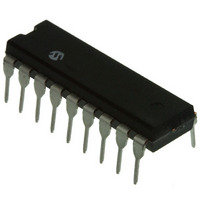PIC18F1320-I/P Microchip Technology, PIC18F1320-I/P Datasheet - Page 14

PIC18F1320-I/P
Manufacturer Part Number
PIC18F1320-I/P
Description
IC MCU FLASH 4KX16 A/D 18-DIP
Manufacturer
Microchip Technology
Series
PIC® 18Fr
Datasheets
1.PIC16F616T-ISL.pdf
(8 pages)
2.PIC18F1220-ISO.pdf
(308 pages)
3.PIC18F1220-ISO.pdf
(8 pages)
4.PIC18F1220-ISO.pdf
(6 pages)
5.PIC18F1220-ISO.pdf
(10 pages)
6.PIC18F1220-ISO.pdf
(4 pages)
7.PIC18F1320-ISS.pdf
(36 pages)
8.PIC18F1220-EP.pdf
(310 pages)
Specifications of PIC18F1320-I/P
Program Memory Type
FLASH
Program Memory Size
8KB (4K x 16)
Package / Case
18-DIP (0.300", 7.62mm)
Core Processor
PIC
Core Size
8-Bit
Speed
40MHz
Connectivity
UART/USART
Peripherals
Brown-out Detect/Reset, LVD, POR, PWM, WDT
Number Of I /o
16
Eeprom Size
256 x 8
Ram Size
256 x 8
Voltage - Supply (vcc/vdd)
4.2 V ~ 5.5 V
Data Converters
A/D 7x10b
Oscillator Type
Internal
Operating Temperature
-40°C ~ 85°C
Processor Series
PIC18F
Core
PIC
Data Bus Width
8 bit
Data Ram Size
256 B
Interface Type
EUSART
Maximum Clock Frequency
40 MHz
Number Of Programmable I/os
16
Number Of Timers
4
Operating Supply Voltage
2 V to 5.5 V
Maximum Operating Temperature
+ 85 C
Mounting Style
Through Hole
3rd Party Development Tools
52715-96, 52716-328, 52717-734, 52712-325, EWPIC18
Development Tools By Supplier
PG164130, DV164035, DV244005, DV164005, PG164120, ICE2000, ICE4000, DM163014, DV164136
Minimum Operating Temperature
- 40 C
On-chip Adc
7-ch x 10-bit
Package
18PDIP
Device Core
PIC
Family Name
PIC18
Maximum Speed
40 MHz
Data Rom Size
256 B
Height
3.3 mm
Length
22.86 mm
Supply Voltage (max)
5.5 V
Supply Voltage (min)
4.2 V
Width
6.35 mm
Lead Free Status / RoHS Status
Lead free / RoHS Compliant
For Use With
DVA18XP180 - DEVICE ADAPTER 18F1320 PDIP 18LDACICE0202 - ADAPTER MPLABICE 18P 300 MILAC164010 - MODULE SKT PROMATEII DIP/SOIC
Lead Free Status / Rohs Status
Lead free / RoHS Compliant
Available stocks
Company
Part Number
Manufacturer
Quantity
Price
Company:
Part Number:
PIC18F1320-I/P
Manufacturer:
Microchip Technology
Quantity:
1 809
Company:
Part Number:
PIC18F1320-I/P
Manufacturer:
BI
Quantity:
16
Part Number:
PIC18F1320-I/P
Manufacturer:
MICROCHI
Quantity:
20 000
PIC18FX220/X320
FIGURE 3-6:
3.3.1
All of the programming examples, up to this point, have
assumed that the device is blank prior to programming.
In fact, if the device is not blank, the direction has been
to completely erase the device via a Bulk Erase
operation (see Section 3.2 “High-Voltage ICSP Bulk
Erase”).
It may be the case, however, that the user wishes to
modify only a section of an already programmed
device. In such a situation, erasing the entire device is
not a realistic option.
The minimum amount of data that can be written to the
device is 8 bytes. This is accomplished by loading the
8-byte write buffer for the panel and then initiating a
write sequence. In this case, however, it is assumed
that the address space to be written already has data in
it (i.e., it is not blank).
The minimum amount of code memory that may be
erased at a given time is one row of 64 bytes and it is
selected using the TBLPTR registers. The sixth LSb of
the TBLPTR address is ignored. The EECON1 register
must then be used to erase the 64-byte target space
prior to writing the data. This is known as a “Row
Erase”.
DS39592F-page 14
PGC
PGD
1
1
4-Bit Command
MODIFYING CODE MEMORY
2
1
3
1
4
1
TABLE WRITE AND START PROGRAMMING INSTRUCTION TIMING (1111)
P5
1
n
2
n
3
16-Bit Data Payload
n
4
n
5
n
6
n
15 16
PGD = Input
n
n
P5A
When using the EECON1 register to act on code mem-
ory, the EEPGD bit must be set (EECON1<7> = 1) and
the CFGS bit must be cleared (EECON1<6> = 0). The
WREN bit must be set (EECON1<2> = 1) to enable
writes of any sort (e.g., erases), and this must be done
prior to initiating a write sequence. The FREE bit must
be set (EECON1<4> = 1) in order to erase the program
space being pointed to by the Table Pointer. The erase
sequence is initiated by the setting the WR bit
(EECON1<1> = 1). It is strongly recommended that the
WREN bit be set only when absolutely necessary.
To help prevent inadvertent writes when using the
EECON1 register, EECON2 is used to “enable” the WR
bit. This register must be sequentially loaded with 55h,
and then 0AAh, immediately prior to asserting the WR
bit in order for the write to occur.
The erase will begin on the falling edge of the 4th PGC
after the WR bit is set.
After the erase sequence terminates, PGC must still be
held low for the time specified by parameter P10 to
allow high-voltage discharge of the memory array.
4-Bit Command
1
0
2
0
3
0
0
Programming Time
P9
2010 Microchip Technology Inc.
4
P10
Data Payload
1
0
16-Bit
2
0
3
0



















